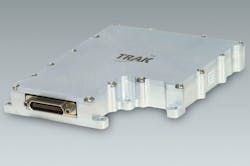Dual-band downconverter model MFC146 translates frequency bands of 10.7 to 11.7 GHz and 11.70 to 12.75 GHz with low noise figure and low phase noise. Supplied in a compact, rugged, low-profile enclosure, the Ku-band downconverter suits very-small-aperture-terminal (VSAT) satellite-communications (satcom) applications such as in-flight entertainment systems and unmanned-aerial-vehicle (UAV) communications. It delivers intermediate-frequency (IF) bands of 950 to 1950 MHz for the 10.7- to 11.7-GHz band and 1100 to 1250 MHz for the 11.70- to 12.75-GHz band. Noise figure is typically around 9 dB and no worse than 13.5 dB, while phase noise is no worse than –95 dBc/Hz. Spurious performance is better than –90 dBc while group-delay variations are ±1 ns. The downconverter, which includes digital band selection and built-in-test-equipment (BITE) circuitry, runs on +7.5 and ±12 V dc; a 10-MHz external reference is required.
TRAK Microwave, (888) 901-7200, (813) 901-7200, FAX: (813) 901-7491
About the Author
Jack Browne
Technical Contributor
Jack Browne, Technical Contributor, has worked in technical publishing for over 30 years. He managed the content and production of three technical journals while at the American Institute of Physics, including Medical Physics and the Journal of Vacuum Science & Technology. He has been a Publisher and Editor for Penton Media, started the firm’s Wireless Symposium & Exhibition trade show in 1993, and currently serves as Technical Contributor for that company's Microwaves & RF magazine. Browne, who holds a BS in Mathematics from City College of New York and BA degrees in English and Philosophy from Fordham University, is a member of the IEEE.
